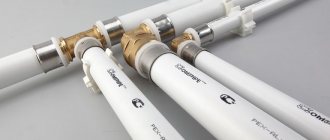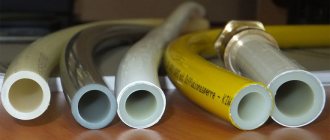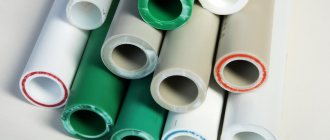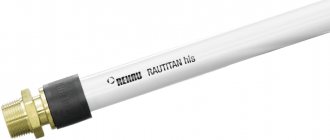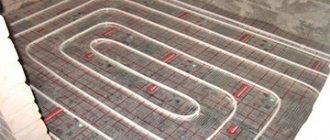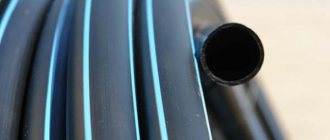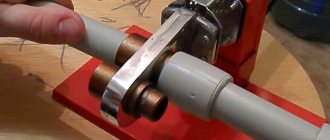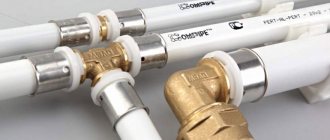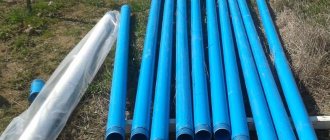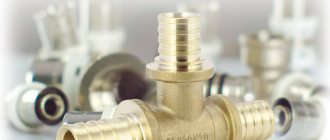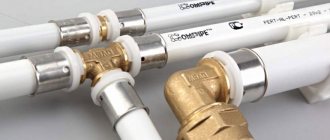Metal pipes have been popular in heating systems for quite a long time, but today they have been replaced by metal-plastic products. Metal-plastic pipes have found their application for the installation of heating systems not only in private homes, but also in industry. They are used for the manufacture of water supply networks, as well as heating and sewer systems. To find out the reasons for such popularity of the products in question, you need to find out all their advantages.
What is a metal-plastic pipe
To find out what a metal-plastic pipeline is, you need to look at a section of a pipe section. The following picture will be visible:
- The first layer is the inner shell, which is made of high-density polyethylene.
- The second layer that envelops the inner shell is aluminum foil. It is connected to the first layer due to the adhesive layer.
- The third layer is the outer layer, which is also made of high-density polyethylene and envelops aluminum foil.
Due to this design, it was possible to obtain highly efficient and reliable pipes that are widely used. Determining the advantages will help you understand all the advantages of this design.
Valtec polypropylene pipes - pros and cons
The properties and technical characteristics of Valtec pipes, as well as their purpose and scope of application, directly depend on the structure of polypropylene parts.
PP pipe parts known today can be multi- or single-layer. Pipe elements of the first type are characterized by the presence of reinforcement with fiberglass or aluminum foil. Thanks to such reinforcing layers, PP risers become stronger and more reliable. The presence of aluminum or a fiberglass reinforcing layer in Valtec reinforced polypropylene pipes only improves the main operational characteristics of pipeline structures.
Possible types of pipes
The range includes the following types of PP pipes:
- non-reinforced products with diameters from 20 mm to 90 mm. Such elements are successfully used to move hot and cold water;
- products reinforced with PN 20 glass fiber. Pipe parts are an excellent option for arranging heating systems and heated floors. They are used for arranging hot and cold water supply systems. The most popular are products with a diameter of 23-63 mm;
- pipes PN 25. This analogue has found application in the construction of high-pressure pipeline systems. The product is a modification of PN 20 pipes, but with improved technical characteristics. The design is capable of withstanding pressure up to 25 atm (PN 20 - up to 20 atm) at a temperature of +90⁰С;
- PP foil reinforced products. They are characterized by improved thermal conductivity characteristics, which ensure high-quality functioning at a thermal load of +95⁰С. Used for heating systems and hot water supply. Outer diameter from 20 mm to 90 mm inclusive.
What is the diameter of PP products
Home water pipes are most often installed from risers with diameters of 20 mm and 25 mm, less often - 32 mm.
The availability of appropriate technical characteristics of Valtec polypropylene pipes allows them to be used for industrial purposes. For this purpose, PP parts with large diameters are used: 40, 50, 63, as well as 75 and 90 mm.
Sewage systems are installed from risers with a diameter of 110 mm.
Important! When choosing a polypropylene pipe for a home pipeline, you should consider not only the required diameter, but also the presence of special attachments for the soldering iron that you have
What do you pay attention to when installing water and heating lines?
For pipeline structures, risers with a diameter of 16-110 mm are most often used
When arranging plumbing and heating systems, pay attention to 3 main characteristics, on which the quality of the structure’s functioning depends
1. Operating temperature range.
Polypropylene pipes are in great demand because they can function successfully at temperatures ranging from +95⁰С and above. In this case, it is necessary to take into account not only the required diameter, but also the amount of pressure that the parts can withstand during operation.
2. Working pressure.
Products PN20 or PN25 are almost always marked. By reading the printed icons and numbers, you can find out in the system with what maximum pressure a particular riser can be used.
3. Presence or absence of reinforcement
In most cases, polypropylene products are reinforced with aluminum or fiberglass. Thanks to the additional layer, the parts become more durable and expand less when heated.
Important! When installing a plumbing or heating system in screed or plaster, use only reinforced polypropylene pipes, which will eliminate the possibility of concrete cracking. Important! Valtec polypropylene reinforced pipes can withstand temperatures of +100⁰С and above, which is very important when laying heating structures
Features of the use of large cross-section pipes
What are the maximum cross-sections of polypropylene pipes?
There are external water mains, mounted from risers with a diameter of 60 cm or more with walls several centimeters thick.
Such structures have some installation features, since their installation is not very easy.
- To prevent the pipeline from being deformed as a result of movement or subsidence of the soil, when installing the pipeline in a busy place, the structure is placed in a reinforced concrete box.
- When installing a pipeline with parts with diameters greater than 30 cm, it is necessary to use special equipment.
- There are no fittings that can be used to connect sufficiently large risers. For joining, special welding machines are used, which ensure reliability and tightness of the connection.
What are the advantages of metal-plastic pipes?
The question of which pipes are better to install when constructing a heating system - metal or metal-plastic - has long been no longer relevant. Indeed, today when arranging a heating system, the question is more about choosing between metal-plastic or polymer. However, first, let’s find out all the advantages that modern metal-plastic pipelines have:
- Smoothness of the inner surface, which avoids the formation of siltation and adhesion of sediments to the walls of the material
- Over time (after 5 or 25 years), the internal surface of the material, which is called the lumen, does not decrease, as is typical for a metal pipe, in which the internal diameter decreases due to blockages, silting, and corrosion.
- Long service life, which exceeds 50 years, but subject to proper operation. Correct operation consists of maintaining the coolant temperature. If the coolant temperature does not exceed 20 degrees, then the product will last at least 50 years, and if its value is up to 95 degrees, then the service life is reduced by 2 times.
- Practical noiselessness during the passage of liquid flow. Residents of apartment buildings know firsthand how noisy metal pipelines are. If you replace all metal products with metal-plastic materials, the apartment will become much quieter, since there will be no extraneous noise from water movement.
- Low thermal expansion rate.
- There is no conduction effect of induced currents.
- Light in weight and easy to install.
- The chemical composition of the inner shell of the pipe is neutral, which makes it possible to use them not only when installing heating networks in the house, but also when installing a water supply system.
- Elasticity - materials bend easily, which allows you to save on the purchase of corner fittings.
- Low thermal conductivity - due to this parameter, it is possible to increase the cooling time of the coolant. The foil in the pipe structure acts as insulation, which reduces heat transfer. Due to low thermal conductivity, the temperature of the coolant practically does not decrease, which allows you to quickly transport warm water to the radiators.
You can build heating from metal-plastic pipes with your own hands not only easily, but also quickly, in contrast to the use of steel pipelines. However, steel devices have the advantage over MP in that only with their help it is possible to construct a gravity heating system.
Another big disadvantage is the low cost, but this is a controversial advantage, since if you compare them with plastic products, then MP is more expensive. When compared with metal pipes of the same length, metal is more expensive, so the price cannot be called low, especially considering the need to purchase expensive fittings.
Repair and service
Metal-plastic pipes have very high technical characteristics; with proper operation, the service life of such a structure can be about 50 years.
But a breakdown may occur due to the fact that the parts were not connected at the proper level or the elements themselves did not meet the technical conditions. A leak can occur at the junction of the pipe or when it is connected to the general system of the house to pipes made of steel.
Failure may be due to poor-quality fittings or due to improper installation. If the leak is caused by a fitting, you can fix the damage yourself using the bypass method. To do this, a piece of the product where the leak has formed is cut out, then it is replaced.
To do this, select a piece of copper pipe of the required size and install fittings at its ends. The copper pipe should first be cleaned to remove any dirt or dust. The copper tube fittings are then inserted into the metal-plastic pipe fittings and pressed into place. Soldering is carried out at the leak site; for this, the joint is heated with a soldering iron or hair dryer.
There are times when a pipe bursts along its length. In this case, it requires complete replacement. But if a leak occurs, and it is not possible to quickly change the pipe, you need to take emergency measures. To temporarily stop the leak, use a bandage or cold welding. To make a bandage, the leak site is covered with a piece of rubber and secured with clamps.
If the crack is small, it can be repaired by cold welding. To do this, it is necessary to drain the water from the damaged area so that the water pressure does not put pressure on the patch. The area to be repaired must be dry. After repair, it is sanded and left for a day until completely dry.
When cold weather sets in, many residents of private homes are concerned that they do not know how to heat the pipe underground if there is no direct access to it. When ice forms, the water can expand in volume, which can cause pipe walls to rupture or crack.
In order to prevent the formation of ice jams, during the installation and laying of communications it is necessary to comply with building codes and regulations. The minimum depth of their location should be lower than the greatest depth of soil freezing.
When laying communications, take pipes with a diameter greater than 48 mm, since thin structures will freeze over their entire thickness. It is better to lay the pipeline in the ground closer to the wall, to structures made of concrete or brick.
To protect against the cold, polyurethane or polypropylene linings or mineral wool sleeves are used. In rooms that will not be heated in winter, the water from the pipes must be drained to avoid a breakthrough.
After replacing old pipes with new ones, many begin to wonder whether they can be painted. Regular enamel paints are not suitable for painting plastic products; you should use alkyd or polyurethane acrylic paint for plastic. To apply it to the pipe, you will need a spray bottle. Before painting, the product is degreased and a primer intended for plastic is applied.
Plastic can be of different types, so some materials will be difficult to paint. Thus, pipes made of polyethylene or propylene cannot be painted well; any paint will peel off the surface.
You will never have to deal with replacing or repairing metal-plastic pipes if you install everything correctly and purchase high-quality material from trusted places and from well-known manufacturers.
To learn about the characteristics of metal-plastic pipes, see the following video.
What are the disadvantages of metal-plastic pipes?
Before making a choice of metal-plastic pipes for heating, you will first need to find out what the disadvantages are in their use.
- Temperature limit. The higher the coolant temperature, the shorter the service life of the product. The coolant temperature should not be allowed to exceed 110 degrees.
- Destroyed at low temperatures.
- Instability to defrosting, so if water freezes in a MP pipe, then when it defrosts, the product will crumble, and a major overhaul of the heating network will be required.
- One of the significant disadvantages is the low rate of thermal expansion. For those who want to build a heating circuit from metal-plastic pipes with their own hands, you need to know that you will also need to additionally include compensators in the system.
- They are not resistant to ultraviolet radiation, so it is not recommended to build a pipeline outdoors or use them in open areas. In this case, the service life will be reduced by 2-3 times.
- The narrowing of the lumen occurs when using fittings, which negatively affects the speed of coolant transportation. The more fittings a MP pipeline system provides, the lower their throughput. That is why, in order not to affect the throughput, when installing a heating system or plumbing, MP products are bent.
- Installation of metal-plastic heating pipes involves the use of crimp, threaded or press fittings. This greatly simplifies installation when compared with metal materials, where a welding machine is needed, or plastic, where a special soldering iron is also indispensable. However, such connection methods have a big drawback - over time they begin to leak at the joints, so periodically it is necessary to tighten the joints. If a pipe is walled up in a wall, then after some time (5-10 years) dampness may form in the wall, which will be caused by deterioration of the connection due to reduced tightness.
- The high cost of connecting fittings, the price of which is 2-3 times higher than for plastic pipes. However, savings can also be made here, since the points of change of direction can be bent instead of using corner fittings.
Most of the listed disadvantages are not disadvantages, but rather operating features, which, if observed, increase the service life of the material. If these conditions are not met, the service life will decrease by 2-3 times, and the pipe will last not 50 years, but 10 or even 5 years. Among all of the above, only one biggest disadvantage should be noted - the need to tighten the joints. This is not only inconvenient, but also unpleasant, since sooner or later a moment will come when there is nowhere to tighten it, and then there will be only one option left - replacing the fitting, and maybe the entire pipeline as a whole.
DIY installation
To install metal-plastic heating pipes in a private house or apartment, you need to study the technology for connecting individual elements, prepare tools, fittings, and tubes.
Requirements for fasteners
Before starting installation work, you need to prepare a set of fittings:
- Detachable couplings. Designed for making temporary connections. They can be collet or threaded.
- Press fittings. Connecting parts that require the use of a special press for installation. The finished connection can withstand high temperatures and pressure.
- Compression fittings. Connecting parts for joining pipes. Disassemble if necessary.
Increased efficiency
To increase the efficiency of pipeline installation and assembly of individual sections, it is necessary to take into account some features:
- Add plumbing flax to threaded connections.
- You can cut metal-plastic tubes using a hacksaw or grinder.
- Be sure to install a special jumper in front of the chokes and ball valves. If it is not installed, the coolant will be adjusted throughout the entire riser.
- To turn the contour, you need to use corner fittings. Try to keep pipe bends to a minimum.
The installation of individual elements depends on the type of fitting selected. For home work, it is better to use detachable parts that are screwed onto the ends of the tubes. We must not forget about wrapping the threads with plumbing flax, which will increase the tightness of the connection.
Watch a video about installing heating radiators using metal-plastic pipes:
Why is foil used in the MP pipe design?
The connecting link in the MP design is aluminum foil, which is located between the outer and inner layers of polymers. The main purpose of the foil is to give the structure greater strength and wear resistance. In addition, aluminum acts as insulation, which maintains the temperature of the liquid.
To eliminate mechanical stress, the foil layer is protected by polymers on the outside and inside. In order for the structure to have a monolithic and integral structure, an adhesive composition is applied to the foil on top and bottom during the manufacturing process. The technical characteristics of MP pipes show high throughput rates for various liquids, which do not decrease over time, which is due to the smoothness of the internal polymer walls.
The outer layer of polymer protects the product from mechanical stress and also prevents the formation of condensation on the foil. In the manufacture of MP pipes, special adhesives are used that have high adhesion resistance. The durability and scope of application of the products in question depend on the quality of the adhesive compositions used.
The aluminum layer in the MP design is also called reinforcing, since it acts as a connecting link between the outer and inner layers of polymers. If we take into account the adhesive composition, then the PM consists of five layers, but it is generally accepted that the base of the pipe uses three layers - two polymers and foil.
Structure
Modern metal-plastic pipes for the heating system are solid, long, hollow inside structures with a circular cross-section, consisting of several layers of materials firmly connected to each other. In their structure, five layers can be distinguished:
- outer – polyethylene;
- the first fixing is glue;
- medium – aluminum foil;
- the second fixing is glue;
- internal - polyethylene.
Polyethylene is a substance produced by the polymerization of ethylene. In the manufacture of pipes, PEX is used - cross-linked polyethylene, that is, a material with a large number of cross-links formed under high pressure. It has increased thermal and deformation resistance.
Structure of a metal-plastic pipe
The smooth inner layer of PEX in the pipe gives the structure strength and protects the aluminum from corrosion, as well as from the deposition of scale and other substances. The outer shell is made of white polyethylene and is intended for decorative purposes and additional protection.
Both PEX layers prevent the formation of galvanic couples between aluminum and steel or brass, from which other elements of the system may be made. In addition, polymers reduce the thermal conductivity of pipes and the rate of steam condensation.
Note: Metal-plastic pipes have now also appeared, the inner layer of which may consist of heat-resistant polyethylene marked PERT.
Aluminum foil, which makes up the central layer of the structure, performs load-bearing and stabilizing functions, provides rigidity and prevents oxygen diffusion. The edges of the metal sheet are joined end-to-end using laser welding. Aluminum partially neutralizes polyethylene's tendency to expand.
The quality of the glue holding the pipe layers together is extremely important. It ensures durable operation and easy installation of metal-plastic pipes for heating installations, preventing delamination of the structure. Manufacturers use individual patented adhesives.
What is the thickness of foil in metal-plastic pipes and what does it affect?
Today, every house and apartment has plumbing or heating systems made of metal-plastic. Moreover, metal-plastic pipes are so easy to use that their installation can be done by hand without the help of specialists. If we compare them with plastic, then to solder them you will need an experienced soldering specialist, and the situation is similar with metal material - it is impossible to build a heating or plumbing system without a welder.
In the design of MP, aluminum foil is considered one of the main components. The absence of foil makes the material a regular polymer. Many people do not know why the foil layer is needed, even when they prefer metal-plastic pipelines. The aluminum layer is assigned a number of tasks:
- Protects against various influences, and not only mechanical ones. Foil in MP pipes prevents destruction of the material under mechanical stress, bending, and pressure changes inside.
- Protects against linear extensions.
- Acts as an oxygen barrier.
Modern manufacturers produce MP pipes in which the aluminum layer has different thicknesses - from 0.15 to 0.6 mm. The larger the layer, the more reliable and efficient the design. Often, when it is planned to build a heating system from metal-plastic pipes in a private house, the cheapest metal-plastic products are purchased. However, their cheapness is not justified by their quality, because the final cost is affected by the thickness of the foil.
It is highly not recommended to buy pipes in which the foil thickness is less than 0.3 mm, especially if you plan to build a heating system or a water supply system with a pump. Such materials are very fragile, and at the slightest excess of the bending angle, they break.
If you need high-quality and reliable materials, it is recommended to use devices with a foil thickness of at least 0.3 mm. These are flexible and reliable pipes that are easy to work with and have a fairly long service life. The smaller the thickness of the foil, the lower the service life, so a 50-year resource is the standard for pipes that are manufactured in accordance with GOST and using a foil layer with a thickness of 0.55-0.6 mm.
Criterias of choice
As soon as metal-polymer pipes appeared in Russia, they immediately won universal recognition. Sales were constantly increasing, although many were wary of the new material. At first, fittings and pipes were supplied from Europe, but since such products were of very high quality, their price was high. When China began producing pipes, the price of the products immediately decreased, but the quality of the products turned out to be lower. After some time, Russia also began producing such products.
- Products made from polyethylene and aluminum will have different indicators, which depend on the diameter. The degree of pressure will directly depend on the selected diameter, so when installing, you need to find out what pressure the pipe can withstand. You may need larger diameter material.
- In order for metal-plastic products to heat a home well, it is necessary to calculate the heat transfer. The heat transfer of a plastic pipe will be 175 times lower than the heat transfer of a steel product, its coefficient is 0.36.
- The attractive appearance of the products made it possible to carry out installation work without breaking through the wall. Such pipes were laid outside the walls. This makes installation and repair of the water supply much easier.
- To select the right material, you can look at the markings that are indicated on the product at certain intervals, or check the data with the seller in a store or market.
- Having carefully studied the markings, it will become clear how suitable the material is for each situation. Experienced craftsmen recommend choosing a pipe with 2 layers of cross-linked polyethylene PE-X/AL/PE-X or PE-RT/AL/PE-RT. These polymers combine well with each other. If the layer consists of PE (ordinary polyethylene), it means that it is only suitable for cold water; when heated to more than 60 degrees, leakage occurs.
- If you need to choose a product for a well, a metal-plastic pipe will successfully replace a metal or asbestos-cement pipe. Currently, a casing pipe with threads is used, designed for wells, thanks to which a durable and strong frame will be created inside the hole. A submersible pump will be lowered inside the frame.
- Such products are produced with a diameter of 9-40 cm; product sizes from 125 mm to 225 mm are most often in demand. If you use it at shallow depths, a pipe with a standard wall thickness will be sufficient; at greater depths, you should choose a product with walls at least 9 mm thick. PVC casing products are produced in blue color.
Manufacturing technology
Aluminum foil is introduced into the structure of a metal-plastic pipe in two ways:
- Laser welding - seamless joining of ends butt-to-end. As a result of this manufacturing principle, pipes with straight walls are obtained. When laser welding, the thickness of the aluminum layer can vary from minimum to maximum.
- Ultrasonic welding - the ends of the foil material are glued together overlapping. To avoid thickening of the foil at the joint, the thickness is slightly reduced, but not always. That is why you can find products in which it is visually clear that the layer thickness is different. The main advantage of a pipe in which the aluminum layer is joined by ultrasound is its low price when compared with analogues produced using a laser. This principle of connecting foil has a negative impact on the technical parameters of the product, so the pipes are not as strong, durable, or wear-resistant as MP using a laser.
If you don’t know which pipe option is best to choose, then you need to rely directly on the type of work being performed. If you plan to build a heating system or plumbing, then it is naturally better to buy MP with butt-type foil. If the device is used for sewer construction or for other purposes, then a pipe with an aluminum overlap joint is suitable.
Diameters
Working with these pipe materials is not difficult if you know the rules. These products conduct heat well and can hold a given shape (in this case, turns). To avoid disturbing the shape of the corner of the heated floor when bending, they should also be bent correctly.
When starting installation, many people are interested in what diameter of metal-plastic pipe is better to choose? Beginning craftsmen are recommended to start with metal-plastic options and take a diameter of 16 mm for installation.
Video
Pipe for heated floor. Select the diameter.
This section for metal-plastic pipes is the most convenient. It is easier to handle and contains a minimal amount of coolant. For example, one meter of a product with a diameter of 16 mm holds 110 milliliters of liquid, and in the “twenty” there are already 180 ml of liquid. This is a significant difference.
Also, a product that has a diameter of 20 is more difficult to process. In this case, the installation of options of this caliber is carried out in increments of 50 cm. Therefore, instead of a diameter of 18-20 mm, it is recommended to install it at 16 mm.
Products of this diameter are not only easier to install, but also cost an order of magnitude cheaper than the “eighteenth” or “twentieth” diameter.
Types of connection
Joining of metal-plastic pipes can be done in two ways:
- via compression fittings
- via press fitting
Docking with compression fittings involves using crimping devices. Their design is: a fitting, a union nut and a split ring. A reliable connection can be created with an ordinary wrench.
This type of connection has the advantage of not requiring any special equipment and the connection can be disassembled if necessary.
Docking with fittings is performed as follows:
- The pipe is prepared and a coupling is put on it.
- The protected side is treated with an expander and flared.
- The pipe “sits” on the fitting of the fitting part, and the sleeve is clamped with a manual or hydraulic press. This completes the docking.
Leak in the heated floor structure
The structure of these products guarantees their strength and resistance to corrosion. If a metal-plastic pipe is leaking, this may be due to the following reasons:
- violation of laying technology;
- mechanical influences;
- poor execution of joints.
Very often the system leaks due to a malfunction of the connecting device. To solve this problem, just tighten the nut. If water continues to leak, the system will need a thorough revision.
It is necessary to check the wear condition of the rubber gaskets on the fitting. After the problem is solved, all joints must be treated with silicone grease and wrapped with sealant.
If a network mounted with press fittings leaks, then you need to dismantle the leaking joint and replace the ring on the tube.
If the pipeline itself is leaking (for example, from a rupture), then it is urgent to replace its damaged part with a new one. If replacement is not possible, the problem must be temporarily corrected. A bandage is used for this.
What plastic is used in production
When making metal-plastic pipes for heating or plumbing, different types of polymers are used. These polymers are:
- Cross-linked polyethylene PEX or linear PE-RT. This type of polyethylene helps provide pipes with maximum strength, as well as reliability and wear resistance. The main advantage of these types of polymers is that they increase the service life of the device several times. Devices made from this material are highly resistant to temperature fluctuations, mechanical influences and pressure variations, and are used both for the construction of a heating network and for the construction of water supply.
- Low pressure polyethylene PEHD, PE-RS, PE, HDPE is a cheaper and less practical material compared to the first. Pipes made using this type of polymer have a narrow scope of application. In particular, the technical parameters of such products are to limit the temperature of the coolant to +75 degrees. It is recommended to use this material for the construction of water supply systems and transportation of cold water. Low-density polyethylene is unstable to ultraviolet radiation, so if the system is installed outside, it must be protected from sunlight.
If you choose a pipe from MP in order to build a heating system at home or in an apartment, then it is recommended to take into account the type of plastic in order to prevent premature wear of the material. If you save money and buy cheap metal-plastic, then in 5-8 years you will need a major replacement of the structure, so this requires a responsible and competent approach to the selection of pipes.
Marking
Installation of heating with metal-plastic pipes begins with their purchase. In order for the consumer to obtain information about the technical characteristics of products, they are marked with indelible paint during production. As a result, a long inscription in one line appears on the outer surface of the pipe.
Main marking elements:
- Manufacturer's name.
- Designation of the certificate (GOST), in accordance with the standards of which the pipe is manufactured.
- Design features of the product. Material – polyethylene (PE-R), cross-linked polyethylene (PE-X), heat-resistant polyethylene (PERT), aluminum (Al). Crosslinking method – peroxide (a), using silane (b), electron flow (c), nitrogen (d).
- Diameter and wall thickness, for example, 16x2 mm. Sometimes there are designations in inches.
- Operating parameters – operating pressure and maximum possible constant temperature.
- The transported liquid is drinking or industrial water.
- Product release date and batch number.
Note: The number of marking elements on pipes may vary depending on the manufacturer.
How does the adhesive composition affect the quality of pipes?
The glue used for the manufacture of MP pipes is a special substance that satisfies the following needs:
- Ensuring connection reliability, as well as withstanding various loads, including mechanical ones.
- Do not have a negative effect on liquids, since in most cases the material is used for the manufacture of plumbing systems through which drinking water is transported.
In addition to binding properties, glue is also responsible for the elasticity of the material. Manufacturers keep secret what kind of glue this is and what it is made of, but what is certain is that, like polymers, it has a corresponding service life. The lower the quality of the glue used, the faster the products will begin to delaminate and crumble. When purchasing a pipe from MP, you need to look at it in cross-section. All three layers, as well as the adhesive composition, must be monolithic, and if signs of delamination are detected, then it is not recommended to buy such pipes.
Multilayer metal-polymer pipes with an aluminum layer
Most of these pipe systems are intended for organizing heating systems (including floor heating) and water supply (cold and hot). The design of the products is indicated in GOST R 53630-2009 for multilayer metal-polymer pipes.
Layer structure:
- outer;
- adhesive;
- barrier;
- adhesive;
- interior.
Materials for the manufacture of metal-polymer pipes
In the production of metal-polymer pipes (MPP), the following can be used:
- ordinary polyethylene, PE or PEHD - for low-pressure cold water supply systems;
- heat-resistant polyethylene, PERT - for cold and hot water supply systems, as well as heating (up to 70 ° C) medium pressure;
- cross-linked polyethylene, PEX – high pressure and temperature pipelines, ultraviolet resistance (from some manufacturers);
- polypropylene.
The thickness of the aluminum layer differs among different manufacturers of metal-polymer pipes and can vary in assortment even within the same production. The thickness of the aluminum layer affects the rigidity of the pipe and should be selected based on the task at hand.
The adhesive composition is extremely important, because it is what forms the single, albeit multilayer, structure of the MPT. The main requirement is good adhesion to aluminum and polymer. The best manufacturers of such adhesives:
- Equistar, USA;
- Hyundai, South Korea;
- Mitsui, Japan.
Russian manufacturers of MPT
The best Russian manufacturers of MPT produce products not only for heating and water supply, but also for many technical and process pipelines.
Products under the COMPIPE brand are produced in the Moscow region (Kashira), and since 2015, partially in Switzerland. In addition to the standard purpose, pipes are used in the distribution of intra-house gas pipelines, in the heating of open areas, and in the organization of “warm floors”. The quality of MPT COMPIPETM made of cross-linked polyethylene, according to reviews, is high. There is feedback from the manufacturer. The company also produces fittings, fittings and tools under the Comtek brand.
NPP Mayak-93 is not only a manufacturer of MPTs, but also develops and supplies equipment for their production. In addition to the above capabilities, their pipes are intended for laying and insulating electrical wiring, in the systems of sea vessels and Russian Railways trains, as well as for technological needs (compressed air, aggressive liquids).
For heating and water supply, the Kazan Metal-Polymer Pipes company produces MPT, in which the inner and outer layers consist of polypropylene. Aluminum foil is welded "overlapping". The thermal conductivity of the walls is lower than with protective layers of polyethylene, so the coolant loses less thermal energy in the route.
The Komplekt-service+ LLC enterprise, Tatarstan, produces products using European technology and from European materials, however, their metal-polymer pipes comply with GOST R 53630-2009 and specifications approved by the Scientific Research Institute of Plumbing. They also use high temperature polypropylene as a protective layer with high resistance to chemical environments. Operating temperature – up to +110 °C. The fittings produced for metal-polymer pipes are universal and suitable for both MPT and polypropylene pipes.
A joint production between Russia and Italy produces Valtec pipes with polyethylene in protective layers. The production features make it possible to use such MPTs with frequent changes in ambient temperature with short-term “peaks” of up to 130°C.
Foreign MMT suppliers
The sales leaders are recognized manufacturers of multilayer metal-polymer pipes with technical characteristics that meet all the requirements of long-term operation. Warranties issued are often 10 years, which indicates the manufacturer's confidence in its products. Here are just a few of them:
Variety FRÄNKISCHE ROHRWERKE
- FRÄNKISCHE ROHRWERKE, Germany;
- HERZ, Austria
- HENCO, Belgium
- RBM, Italy;
- TECE, Germany;
- REHAU, France;
- GIACOMINI, Italy;
- COES, Italy.
There are many Italian and German manufacturers of high-quality MPT. There are also manufacturers from Korea and China on the market. When choosing the technical characteristics of metal-polymer pipes from various manufacturers, take time to study the product labeling. There are many fakes on the market, especially HERZ and HENCO, which do not correspond to the original pipes.
Smooth and corrugated pipes GIACOMINI for gas supply
Metal-polymer pipes have proven themselves well in heating, water and gas supply, and other areas. The products have a long service life and reliable guarantees, but beware of fakes and poor-quality installation - contact professionals.
What diameter are metal-plastic pipes?
The diameter of a metal-plastic pipe is the main indicator that must be taken into account depending on the purpose for which the material is used. The buyer is accustomed to the main indicator - this is the outer diameter, however, when purchasing, the following information on the standard sizes of plastic pipes must be taken into account:
- The internal passage size is a key indicator of material throughput.
- External size - for MP products its size ranges from 16 to 63 mm. Small-diameter products are used for arranging heating and plumbing systems, and larger ones are used for arranging sewer networks.
- Wall thickness - the value ranges from 2 to 4 mm. The higher the wall thickness, the better. The larger the outer diameter of the device, the thicker its walls should be.
Standard sizes of metal-plastic pipes and their application:
- Sizes 16 mm and 12 mm with a wall thickness of 2 mm - used to ensure water supply to mixers and the meter.
- Dimensions 20*16 and 2 mm - used to create a warm floor.
- Dimensions 26*20 and 3 mm - used to create heating systems and water supply systems, as well as for the construction of risers and heated floors.
- Products 32*26 with 3 mm - suitable for the construction of the main pipeline and riser.
- Products 40*32 and 3.9 mm - with their help, centralized heating and water supply are installed in multi-storey buildings.
Physical and technical characteristics
The properties of metal-plastic pipelines depend on the dimensions of the product (diameter, wall thickness), type of polymer and manufacturer. However, all indicators must comply with the standards of GOST 18599 (2001), R-53630 (2009) and R-52134 (2003).
Additional characteristics: material of the inner and outer layer – cross-linked polyethylene, thermal conductivity coefficient of pipes 16/20 mm – 0.41 W/mk, 26 mm – 0.39 W/mk
General requirements for metal-plastic mains according to GOST:
- yield strength of the hot plastic layer – up to 0.3 g/10 minutes;
- no delamination of the leading edge when stretched up to 10%;
- minimum permissible resistance to delamination under loads is 15 N/cm, without loads – from 50 N/cm;
- cross-linking of polyethylene layers – from 60%;
- thermal stability of plastic components;
- the limit value of oxygen permeability at a temperature of +40°C is 0.32 mg/sq.m*day, at +80°C – 3.6 mg/sq.m*day;
- the degree of strength of the polymers used is from 8-12 MPa;
- the initial fluidity temperature of the adhesive composition is at least +120°C.
GOST also regulates environmental parameters. The proportion of volatile substances in metal-plastic pipes should not exceed 0.035%.
Basic averaged physical and technical characteristics:
- Assortment. Manufacturers offer metal-plastic moldings with an internal cross-section of 14-60 mm and a wall thickness of 2-3 mm. The length of the bay is 50-200 m.
- Durability . Under lateral load conditions, the minimum tensile strength is 2880 N. The strength of welding to metal and adhesive joints is 57 and 70 N/sq.mm.
- Heat resistance. The composite retains its characteristics within a temperature range of +95°C. Let’s assume a short-term jump to +110°C; at -40°C the thermoplastic freezes.
- Linear parameters. The bending radius is directly proportional to the diameter of the pipe line. For manual installation, the value is 80-125 mm, for machine installation (pipe bender or jig) - 46-95 mm.
The pressure limit in the system depends on the temperature of the transported agent.
At a coolant temperature of 25°C, the product can withstand a pressure of 25 atmospheres, at 95°C – 10 atmospheres. If a liquid of 20°C is transported, then destruction of the pipeline will occur under pressure of over 80 atmospheres
If it complies with the passport operating standards, the service life of the metal plastic is 50 years. When used in “hot” utility networks (coolant temperature above 25-30°C), the operating period is reduced to 25 years.
Choosing metal-plastic pipes for installing a heating system
To begin with, before choosing an MP pipe, you need to decide for what purpose you plan to use it. If this is a centralized heating system, then the pressure in such networks usually does not exceed 4 atmospheres. For autonomous networks, this figure almost never exceeds 1.5 atmospheres. It is also necessary to take into account temperature indicators, which do not exceed 70-90 degrees. Most modern boilers have the option of monitoring and regulating the coolant temperature.
All these indicators indicate that MP pipes can be used to build a heating system. When choosing metal-plastic for the construction of a heating system, one important parameter must be taken into account - this is the low linear expansion rate. If you plan to constantly heat the house, that is, maintain the water temperature in the system above 20 degrees, then the material can be used. If there are changes in coolant temperature, the pipes will fail very quickly, so they will need to be replaced.
If a solid fuel boiler is used as a source of heat injection, in which there is no option to control the temperature of the coolant, then it is possible that the temperature values may increase above 90 degrees. To prevent a critical rise in temperature, it is recommended to use heat accumulators, otherwise the pipes will quickly fail.
In conclusion, it should be noted that only after choosing the appropriate diameter of the product, you will also need to buy fittings for the pipe. These are connecting elements due to which two pipes are connected, as well as changes in direction, transitions, etc. MP fittings are not cheap, so when choosing between metal-plastic and plastic for constructing a heating system in a house, you need to immediately weigh all the advantages and disadvantages, and only then make the appropriate, correct and competent choice.
Pressure testing of the water supply system
When the installation of a water supply system made of metal-plastic pipes is completed, it is necessary to check it for leaks using the pressure testing process:
- It is necessary to shut off the test area filled with water to seal it (using taps/valves).
- Connect a pump to the connection pipe of one of the taps (a manual, low-power one is suitable for a home water supply system).
- Using a pressure testing pump, pump water into the selected area at a pressure greater than the calculated operating pressure, then turn off the pump and record the pressure gauge readings.
- Maintain the system under pressure for some time - at least half an hour.
- Then the current pressure gauge readings are compared with the original value. If the two values are different, something has gone wrong, there is a leak.
Pipe pressure testing pump If you have an open gasket, the problem area can be detected visually. After eliminating the malfunction, you will have to re-pressure test.
Areas of use
Due to their properties, metal-plastic pipes are used in various fields, namely:
- in heating systems for supplying coolant to radiators in apartments and private houses;
Supplying water to the radiator with metal-plastic pipes
- in hot and cold water supply communications;
- for arranging heated floors in residential premises, gyms, swimming pools;
- for drinking water supply
- in air conditioning and ventilation systems;
- for supplying gas and aggressive liquids in industry and agriculture;
- to protect electrical wires and cables;
- for transporting compressed air;
- for the construction (repair) of water and railway transport;
- in watering and irrigation systems from wells (wells).
- in areas where there are heat sources with temperatures above 150 °C;
- when installing heating systems with elevator units;
- in rooms with fire safety category “G” (they contain substances that, when processed, generate sparks and radiant heat).
However, metal-plastic pipes cannot be used:
Metal-plastic pipes combine the best properties of polyethylene and metal products. However, they are relatively inexpensive. They are widely used in everyday life and industry for the installation of heating and plumbing systems. If the operating standards are followed, the structures can last up to 50 years.
Source
Advantages and disadvantages
High-quality metal-plastic pipes for water supply and heating systems have the following advantages:
- resistance to corrosion, including in aggressive environments;
- lack of tendency to deposit salts, silt and other substances on the inner surface;
- flexibility and ductility - pipes can be profiled if there is a need to bend around existing structural elements;
- light weight;
- resistance to negative temperatures;
- smooth inner layer - a low roughness coefficient allows you to maintain stable pressure when liquid moves through pipes, as well as high throughput (30% more than that of metal structures);
- service life - 50 years, for comparison - steel pipes last 15-20 years;
- minimal expansion when exposed to high temperatures;
- no influence on the composition of the transported liquid;
- environmentally friendly - materials do not emit toxic substances;
- low thermal conductivity;
- soundproofing properties;
- non-conductivity of stray currents;
- no need for painting due to aesthetic appearance.
Metal-plastic pipes are produced in coils.
Another significant advantage is the fact that heating from metal-plastic pipes can be installed and repaired with your own hands without any difficulties:
- assembly requires simple tools;
- no welding equipment is needed - the pipes are connected using fittings;
- little waste is generated during the work;
- due to flexibility, you can do without a large number of additional elements;
- metal-plastic is compatible with other materials.
According to experts, the best metal-plastic pipes are produced by Valtec (Italy and Russia), Ape (Italy), Henco (Belgium), Uponor (Germany), Rehau (Germany), Nanoplast (Russia), Oventrop (Germany).
Disadvantages and features of products:
- Metal and plastic have different expansion coefficients. Constant temperature changes over time lead to weakening of the joints, which can result in leaks.
- Repeated bending damages the pipe structure. You can create corners only with a certain radius and step. It is advisable to use special pipe bending machines. You cannot twist elements around an axis.
- Using fittings instead of welding or soldering does not allow for the creation of monolithic connections, which increases the risk of leaks. It is not recommended to use threaded fittings for metal-plastic pipes for hidden pipeline installations.
- The structure of polyethylene is damaged under the influence of ultraviolet radiation.
Using press fittings you can create a reliable permanent connection
Advice: Plastic pipes should be laid with some reserve. In places of bends it is necessary to install compensatory loops. External systems should be thermally insulated.
Rating of the main manufacturers
The rating of metal-plastic pipes includes products from the following companies:
- Valtec;
- Ape;
- Henco;
- Kermi;
- Uponor;
- Rehau;
- Sanha;
- Oventrop Copipe;
- Hydrosta.
Pipeline products from Valtec (Italy) are made from high-quality polymers and purified aluminum. The layers of pipes are distinguished by tight joining, which prevents delamination during operation and temperature changes. Products are certified in accordance with European standards.
The products are recommended for insulating floors, connecting heating appliances, water supply systems, transporting carbon-based fuels, non-food and food products in industrial environments. Valtec pipes have a low expansion coefficient and can be used for installation under concrete screeds. The list of product advantages includes durability (shelf life exceeds 50 years), resistance to thermal effects, chemical compositions, and anti-corrosion characteristics. The products can be used at a temperature of +95°C.
Metal-plastic pipes for cold and hot water supply from the company Ape (Italy) are designed for installation in cottages, residential complexes, and industrial buildings. The brand's products are optimal for installation in plumbing and heating systems, as well as for the installation of air conditioning systems. Ape products are distinguished by their plasticity; a small number of fasteners are used when installing systems. Fittings made of brass alloys are supplied with the pipes. The products are high-quality, certified, do not silt, and have anti-corrosion protection.
Metal-plastic pipes from the manufacturer Henco are certified according to European standards. The products provide silent operation, are electrically safe, easy to install, flexible, durable, and heat-resistant. The roughness parameter of the internal coating reaches 7 microns. The outer layer is made of cross-linked polyethylene, ensuring the tightness of the product. The products are used in water supply networks, heating systems, air conditioning and water treatment systems. The pipes are suitable for heating swimming pools, sports fields, and stairwells.
Uponor produces pipelines with a wide range of diameters (16-110 mm). The company uses high-quality materials, and the work is carried out in automated production. The advantage of the products is safety, environmental friendliness, easy installation and maintenance. The pipes are plastic and can be installed in complex plumbing systems. The product is supplied complete with fittings and fasteners. The products are suitable for professional installation and work in private homes.
The Rehau company (Germany) produces complex equipment for heating systems and plumbing structures. The advantage of the company’s pipes is the preparation of the necessary components (fittings, shut-off valves, transport units). Metal-plastic products are distinguished by dense cross-linking of layers of polymers and aluminum, and have shape memory characteristics.
Advantages of Rehau pipes:
- resistance to mechanical damage and scratches;
- the ability to bend pipelines without specialized equipment;
- resistance to increased loads;
- compliance with European quality requirements.
The Oventrop Copipe company produces pipes of medium diameters (16-63 mm), the products are supplied with special fittings. Products are high quality and affordable. Multilayer pipelines operate stably at a temperature of +95°C. PE-Xc polyethylene is used for the inner layer, and PE-Xb polymers are used for the protective outer layer. The pipelines are butt welded, a method that ensures tightness and durability.
Sanha (Germany) products are certified according to European standards and are made from modified polymers. The products are high quality, environmentally friendly, strong and durable. The products are designed for heating systems, water supply and cooling complexes, and transportation of liquid media in industrial complexes. At a temperature of +95°C, the products are resistant to pressure up to 12 bar.
Metal-plastic pipes for hot water and cold water supply from Hydrosta (South Korea) are available with diameters of 16-50 mm. The products are optimal for residential buildings and industrial complexes. Installation of pipes can be carried out outside or indoors. The products are durable, treated with anti-corrosion compounds, installation requires a small number of fittings, the material is plastic, used for complex design solutions.
